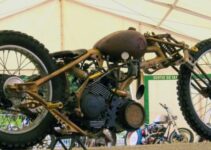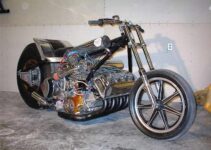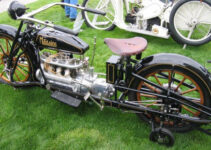Choppers make the best motorcycles
This is for people who want to know how to buy or build a low-cost Chopper and while everybody has their own opinions the material that follows has worked for me and others and may deserve some consideration if you’re serious about owning a hot bike.

Affording the chopper
The preferred method of getting a low cost chopper project off the ground, and probably the least expensive proposition in the long run, is to buy a complete bike to begin with. It doesn’t make much difference whether it is running or not at least you’ll have 95% of all the bits and pieces you’ll ever need and you can refurbish it a little at a time as the budget permits. As you continue reading the Handbook always keep this in mind. Buying a complete bike, regardless of the condition, will almost always to be cheapest way to begin a project.
If you watch ebay and the swap meets at the various forums and attend local shows and swap meets you can pick up a pretty good assembled but non-functional bike for under $6000. It is not unusual to find one running, but not necessarily roadworthy, for under $7000. I’ve seen some very nice machines that I’d be happy to ride for under $8500 but in almost all cases you have to have the cash and you have to act on the sale immediately and you have to be willing to pick the bike up regardless of where she’s presently parked.
If you’re willing to buy a ‘basket-case’, or a bike that’s completely disassembled, you can find some really good deals under the four or five thousand dollar mark but you probably won’t have all of the parts you’ll need to get it put back together but at least it’s a good starting point.
The so-called ‘Kit Bikes’ or ‘Rollers’ are probably the worse thing you can buy since they are typically marked up at least 200 and even 300% over the wholesale cost of the individual parts and some of these kits are of the worse possible quality being slapped together with whatever stuff is easily available.
To make a long story short there is a direct but complicated correlation between time and money. If you spend a lot of money over a long period of time it doesn’t seem like much and this is the secret of supporting a very expensive habit. Conversely if you have a lot of money you can compress the time frame.
One of the biggest problems the potential bike owner/builder faces is stagnation of the ‘project’. You have to be able to allocate both money and time in equal proportions otherwise the project will run up against countless ‘stoppages’ or interruptions in its progress and you’ll end up frustrated, run out of patience, and sometimes even become disinterested in the entire ordeal and shit-can the whole project.
The ideal situation is to be able to spend a little time each day or week working on the bike while being in a position to spend the funds necessary to buy the parts and other stuff you’ll be needing to keep the project progressing just slightly beyond you’re frustration level each and every day. Having a bare frame sitting in the garage for a whole year before you get some more cash to take it to the next stage isn’t what I call progress.
When I first started out building bikes I had very little money. In fact I remember not being able to eat on a regular basis so I guess you could say I had a cash flow problem. On the other hand I had plenty of time on my hands and I was willing to do as much work as needed to be done so I didn’t mind working on really bad basket cases just as long as I could see a little progress being made every day.
I started my own so-called ‘biker life’ with a running ride but economics soon dictated that I sell that particular scooter. It wasn’t too long however that the old hankering came back and I started looking for another motorcycle but funds were slim to none so I developed a ‘plan’ that would get me back in the saddle without getting a divorce. I’d just build my own bike from what ever junk parts I could scrounge up a little at a time. What I couldn’t buy, I’d build myself.
The ‘Plan’ consisted of buying, borrowing, begging and trading for Harley parts every weekend. I’d settle for the least-cost, most beat up, most rusted stuff you could possibly imagine and I’d spend the next five days bring those parts back to life again with raw manual labor. No matter how insignificant a part was I would spend all my spare time getting it as close to useable as possible. What I actually didn’t need myself I would then resell or trade for parts that I did need for my particular project.
I was constantly busy and ‘involved’ in my project so I didn’t have time to loose interest or become frustrated with a lack of progress. I could see something happening each and every day and I knew that as each day passed I was that much closer to having a running scooter again.
What I couldn’t afford to buy I learned how to make, or at least modify, and this is the primary reason I started to learn about frame geometry and frame construction techniques. I ended up building my own extended forks using an old stock springer and Ford radius rods for the new legs. Eventually I ended up building an entirely new frame to replace the old stock hardtail that I bought at the inception of the project.
One reason so many bike projects end up for sale before they’re finished is because the project’s owner wouldn’t settle for second or third best and always tried to build the ultimate bike right from the start. My concept involves building literally anything that can roll, even if it only rolls down the driveway. It may look like a Frankenstein creation at the beginning but at least you can get it running for minimal cash outlay. Once you get the basics together, and it goes straight, it’s relatively easy to dress it up one piece at a time. Like I said before I’ve never really had a bike that I considered 100% finished, each one has been a work in progress.
It took almost three years to finally get my second bike on the road but I can honestly say that it cost less than $2000 in cash (back in 1968) to have a ride that today would cost about fifteen thousand dollars.
The real key to my ‘plan’ however was having access to knowledgeable people who could show me what I needed to do, how to do it, and then show me how to perfect the skills to do any particular job the right way. None of these people charged me anything for helping me even though may of them ran commercial shops of their own and this brings me to a central point.
What has happened to the bike building industry between 1968 and now? Perhaps more importantly what has happened to Bikers in general over the same time period? How many so-called custom chopper shops today will even bother to give a customer the time of day let alone show them how to rake a steering neck?
To build a really nice bike on limited funds takes far more resources than a single individual can provide and this means that you’ve got to call upon other people to help you out. You can have friends help out for free or you can hire so-called ‘pros’ to do some stuff for a ‘fee’ but you’ve still got to have outside help every now and then. This ‘circle’ of resources used to be your local cycle club but unfortunately most cycle clubs today are social organizations and the bikes come in second place. If you move down one tier on the social ladder however you might be lucky enough to run into a ‘cycle gang’. Contrary to popular belief such ‘gangs’ weren’t formed to rape, pillage, plunder and steal, but to help other riders build or maintain their scooters. When I want a straight answer to a really serious question I won’t go the local Harley Riders Club but I will try to find some old guy still flying his ‘colors’ to give me some info. I make a pretty unique distinction between and ‘club’ member and a ‘gang’ member in that most ‘gang’ members actually get their hands dirty so I figure that most of the time they know what they’re talking about from first hand experience and not from some discussion board dribble.
On the opposite hand if you’ve got some knowledge or talent you owe it to others to share those things freely, or at least reasonably. We’ve all got to make a living but we don’t have to make a killing on each and every project. The ‘biker’ world is a small world and there is more than enough money to go around so it rubs me raw to see some half-assed prima-don somewhere charging outrageous prices for mediocre work.
In a very small way creating this little web site is my own way of paying back those people who taught me what I know today. This is free information, nobody has to buy my frame plans to have access to the site and I’m not afraid I’ll lose any money by publishing the ‘how-to-do-it’ sections. In fact I look on this whole operation as an investment because someday I’ll eventually need some help with something and maybe, just maybe, somebody will be willing to help out for free in return for what I’ve given them earlier.
I think that the time has perhaps come for the old traditional ‘Cycle Club’ or ‘Cycle Gang’ to take it’s rightful place again as not only a gathering place for members but as a school of learning, sharing and pooling resources. – Chopper Handbook






